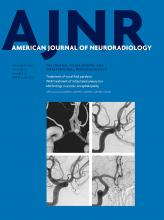Index by author
Agarwal, V.
- You have accessReply:G.M. Lagemann, M.P. Yannes, A. Ghodadra, W.E. Rothfus and V. AgarwalAmerican Journal of Neuroradiology September 2016, 37 (9) E62; DOI: https://doi.org/10.3174/ajnr.A4880
Ahuja, A.T.
- HEAD & NECKYou have accessDiffusion-Weighted Imaging of Nasopharyngeal Carcinoma: Can Pretreatment DWI Predict Local Failure Based on Long-Term Outcome?B.K.H. Law, A.D. King, K.S. Bhatia, A.T. Ahuja, M.K.M. Kam, B.B. Ma, Q.Y. Ai, F.K.F. Mo, J. Yuan and D.K.W. YeungAmerican Journal of Neuroradiology September 2016, 37 (9) 1706-1712; DOI: https://doi.org/10.3174/ajnr.A4792
Ai, Q.Y.
- HEAD & NECKYou have accessDiffusion-Weighted Imaging of Nasopharyngeal Carcinoma: Can Pretreatment DWI Predict Local Failure Based on Long-Term Outcome?B.K.H. Law, A.D. King, K.S. Bhatia, A.T. Ahuja, M.K.M. Kam, B.B. Ma, Q.Y. Ai, F.K.F. Mo, J. Yuan and D.K.W. YeungAmerican Journal of Neuroradiology September 2016, 37 (9) 1706-1712; DOI: https://doi.org/10.3174/ajnr.A4792
Annunziata, S.
- PEDIATRICSYou have accessWidespread Focal Cortical Alterations in Autism Spectrum Disorder with Intellectual Disability Detected by Threshold-Free Cluster EnhancementV.E. Contarino, S. Bulgheroni, S. Annunziata, A. Erbetta and D. RivaAmerican Journal of Neuroradiology September 2016, 37 (9) 1721-1726; DOI: https://doi.org/10.3174/ajnr.A4779
Arnold, D.L.
- ADULT BRAINOpen AccessManual Segmentation of MS Cortical Lesions Using MRI: A Comparison of 3 MRI Reading ProtocolsJ. Maranzano, D.A. Rudko, D.L. Arnold and S. NarayananAmerican Journal of Neuroradiology September 2016, 37 (9) 1623-1628; DOI: https://doi.org/10.3174/ajnr.A4799
Askin, G.
- EDITOR'S CHOICEADULT BRAINOpen AccessQuantitative Susceptibility Mapping and R2* Measured Changes during White Matter Lesion Development in Multiple Sclerosis: Myelin Breakdown, Myelin Debris Degradation and Removal, and Iron AccumulationY. Zhang, S.A. Gauthier, A. Gupta, W. Chen, J. Comunale, G.C.-Y. Chiang, D. Zhou, G. Askin, W. Zhu, D. Pitt and Y. WangAmerican Journal of Neuroradiology September 2016, 37 (9) 1629-1635; DOI: https://doi.org/10.3174/ajnr.A4825
The authors characterized lesion changes on quantitative susceptibility mapping and R2* at various gadoliniumenhancementstages (nodular, shell-like, nonenhancing) in 64 patients with 203 lesions. They found that: 1) active MS lesions with nodular enhancement show R2* decrease but no quantitative susceptibility mapping change; 2) late active lesions with peripheral enhancement show R2* decrease and quantitative susceptibility mappingincrease in the lesion center; and 3) nonenhancing lesions show both quantitative susceptibility mapping and R2* increase, reflecting iron accumulation.
Baek, B.H.
- INTERVENTIONALYou have accessIncidence and Clinical Significance of Acute Reocclusion after Emergent Angioplasty or Stenting for Underlying Intracranial Stenosis in Patients with Acute StrokeG.E. Kim, W. Yoon, S.K. Kim, B.C. Kim, T.W. Heo, B.H. Baek, Y.Y. Lee and N.Y. YimAmerican Journal of Neuroradiology September 2016, 37 (9) 1690-1695; DOI: https://doi.org/10.3174/ajnr.A4770
Baradaran, H.
- ADULT BRAINOpen AccessApplication of Blood-Brain Barrier Permeability Imaging in Global Cerebral EdemaJ. Ivanidze, O.N. Kallas, A. Gupta, E. Weidman, H. Baradaran, D. Mir, A. Giambrone, A.Z. Segal, J. Claassen and P.C. SanelliAmerican Journal of Neuroradiology September 2016, 37 (9) 1599-1603; DOI: https://doi.org/10.3174/ajnr.A4784
Bechan, R.S.
- FELLOWS' JOURNAL CLUBINTERVENTIONALOpen AccessWEB Treatment of Ruptured Intracranial AneurysmsW.J. van Rooij, J.P. Peluso, R.S. Bechan and M. SluzewskiAmerican Journal of Neuroradiology September 2016, 37 (9) 1679-1683; DOI: https://doi.org/10.3174/ajnr.A4811
This observational cohort study evaluated 32 patients with 32 acutely ruptured aneurysms endovascularly treated with the Woven EndoBridge (WEB) device. The mean aneurysm size was 4.9 mm, with 14 less than or equal to 4 mm, and most had a wide neck. All aneurysms were adequately occluded, and there were no procedural ruptures or complications related to the WEB device. No adjunctive stents or balloons were needed. Seven patients with poor clinical grade died during hospital admission due to the sequelae of their subarachnoid hemorrhage. The authors conclude that WEB treatment of small ruptured aneurysms was safe and effective without the need for anticoagulation, adjunctive stents, or balloons.
Benaissa, A.
- INTERVENTIONALYou have accessContrast-Enhanced and Time-of-Flight MRA at 3T Compared with DSA for the Follow-Up of Intracranial Aneurysms Treated with the WEB DeviceC. Timsit, S. Soize, A. Benaissa, C. Portefaix, J.-Y. Gauvrit and L. PierotAmerican Journal of Neuroradiology September 2016, 37 (9) 1684-1689; DOI: https://doi.org/10.3174/ajnr.A4791



